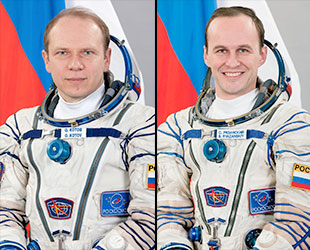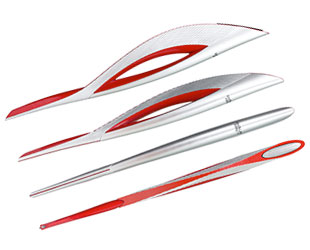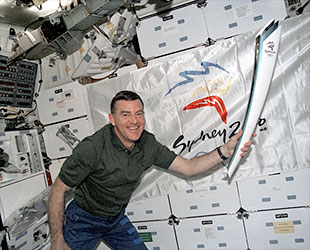April 23, 2013 — Russia may shift its rocket launch and spacewalk schedule to send the torch — and maybe even the flame — for next year's Olympics to the International Space Station (ISS), according to Russia's federal space agency and local media reports.
Set to host the 2014 Winter Games in Sochi on the Black Sea coast, Russia plans to launch the traditional Olympic torch relay later this year on Oct. 7. As the flame passes between runners in 2,900 towns and cities spread across the country, a replica of the torch and perhaps an imitation of its flame will lift off on a Soyuz spacecraft with the next crew members for the space station.
"No decision has been made so far whether an imitation of the Olympic flame or a torch without fire would be moved into outer space," a source in Russia's rocket industry told the Interfax-AVN news service. "No member of the state commission will assume responsibility for moving an open flame close to the Soyuz spacecraft or the ISS."
Flame or no flame, Russia's space agency Roscosmos is planning to do more than deliver the torch to the orbiting outpost, a feat that has been achieved before. The idea is to have cosmonauts carry the torch outside the station on a spacewalk prior to it returning to Earth.

If approved, cosmonauts Oleg Kotov (left) and Sergei Ryazansky will carry the Olympic torch on a spacewalk. (Roscosmos) |
According to the Interfax report, the Olympic torch will be "moved into open space" by cosmonauts Oleg Kotov and Sergei Ryazansky, who will arrive at the space station in late September.
To choreograph the orbital torch relay, Roscosmos and its International Space Station partners, including NASA, will need to agree on adjustments to the schedule of launches and spacewalks.
To deliver the lit or unlit torch to the space complex, the planned Nov. 25 liftoff of Soyuz TMA-11M would need to launch almost three weeks earlier on Nov. 7. Roscosmos cosmonaut Mikhail Tyurin, NASA's Rick Mastracchio and Japanese astronaut Koichi Wakata would fly to the space station with the torch.
The spacewalk, which would include other, more routine maintenance tasks for the two cosmonauts to complete in addition to carrying the torch, would then take place during the brief time between the arrival of Soyuz TMA-11M and the departure of Soyuz TMA-09M.
Under the proposed plan, Roscosmos cosmonaut Fyodor Yurchikhin, NASA astronaut Karen Nyberg and European Space Agency (ESA) astronaut Luca Parmitano will stay in space at least a day longer than originally scheduled to return to Earth with the torch on Nov. 11.

Designed in the shape of a feather, the torch is also reminiscent of the Firebird, or Phoenix — the legendary bird that rose from the ashes and which features prominently in Russian folklore as a symbol of good fortune and happiness. (Sochi 2014) |
The torch's handoff between crews would also result in a short period when nine people would be aboard the space station, a departure from what has in recent years become the norm for crew changes, when the prior crew of three would leave before the next crew arrives.
One of the key symbols of the Games, the torch for the 2014 Sochi Olympics was designed by a team of famous Russian designers and engineers. The aluminum and red torch — red being the traditional color of Russian sports — was crafted to evoke the feathers of a Phoenix, which folklore says brings good fortune and happiness.
How the torches on the ground — there are 14,000 being produced — will differ from the one launching into space, and how the flame will be simulated or safely achieved in orbit, if it is flown, has yet to be released.

STS-101 mission specialist James Voss holds aloft a replica of the Sydney 2000 Olympic torch aboard shuttle Atlantis. (NASA) |
If approved, the torch's trip will mark the second time the Olympic torch has arrived aboard the International Space Station. In May 2000, the space shuttle Atlantis launched the STS-101 mission to the orbiting outpost with a replica of the Sydney Summer Olympics torch.
Four years earlier on shuttle Columbia's STS-78 mission, the crew carried an unlit torch into orbit and then took part in the ground-based torch relay soon after landing back on Earth.
The Olympic flame, without the torch, also made its way through space in the form of an electric signal. As part of the 1976 relay, the flame was sent from Greece to Ottawa via satellite. Heat sensors in Greece detected the flame, the signal was transmitted overseas and a laser beam lit the torch.
